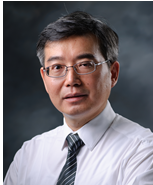 梅雅俊 ,Ph.D.
梅雅俊 ,Ph.D.  單位: 長庚大學
單位: 長庚大學  現職: 生物醫學系 助理教授
現職: 生物醫學系 助理教授  聯絡地址: 333桃園市龜山區文化一路259號
聯絡地址: 333桃園市龜山區文化一路259號 電話: 03-2118800 轉 3641
電話: 03-2118800 轉 3641 E-mail: jmeir@mail.cgu.edu.tw
E-mail: jmeir@mail.cgu.edu.tw




 研究領域:
研究領域:
- 組織工程
- 幹細胞
- 再生醫學
 工作經歷:
工作經歷: August 2008 – present: Assistant Professor, Department of Biomedical Sciences, Chang Gung University.
August 2007-July 2008: Vice President of Research and Technology, Celgenomics, LLC.
August 2005-July 2007: Assistant Research Scientist, Center for Molecular Chaperone/Radiobiology and Cancer Virology, Medical College of Georgia.
July 2001-July 2005: Postdoctoral fellow, Department of Environmental Toxicology, University of California, Santa Cruz, CA.
 學歷:
學歷: PhD. Vanderbilt University
 代表論文:
代表論文:1. The FASEB Journal 27 (11), 4429-4443 (2013) Yaa-Jyuhn James Meir, Angelique Lin, Meng-Fan Huang, Matthew T. Weirauch, Hsiang-Chen Chou, Siang-Jin Ashley Lin, and Sareina Chiung-Yuan Wu
2. Current Biology 17(7), 592-8 (2007) Sakaguchi-Nakashima A., Yaa-Jyuhn James Meir, Yishi J., Matsumoto K., & Hisamoto N. LRK-1, a C. elegans PARK8-Related Kinase, Regulates Axonal-Dendritic Polarity of SV Proteins.
Proc Natl Acad Sci USA 103(41), 15008-13 (2006). Wu SC*, Yaa-Jyuhn James Meir*, Coates CJ, Handler AM, Moisyadi S, Pelczar P, Kaminski JM (2006). piggyBac is a flexible and highly active transposon as compared to Sleeping Beauty, Tol2, and Mos1 in mammalian cells.
Molecular Microbiology 60(2), 331-348 (2006). Bently Lim, Yaa-Jyuhn James Meir, and Fitnat Yildiz. Cyclic-di-GMP signal transduction system in Vibrio cholerae: Modulation of Rugosity and Biofilm formation.
Genes and Development 13(21), 2774-2786 (1999). Angela R. Winnier*, Yaa-Jyuhn James Meir*, Jennifer M. Ross, Nektarios Tavernerakis, Monica Driscoll, Takeshi Ishihara, Isao Katsura, and David M. Miller, III. UNC-4/UNC-37-dependent repression of motor neuron-specific genes controls synaptic choice in Caenorhabditis elegans.
 所有論文著作一覽表
所有論文著作一覽表 學會與認證:
學會與認證:台灣幹細胞學會會員
輻射安全認證
 目前進行中研究計畫:
目前進行中研究計畫:2013/07/01~2016/06/30 Establishing cellular disease models of Taiwanese sialidosis type I for modeling the progression of neurosomatic manifestations and developing patient specific therapeutic strategy


